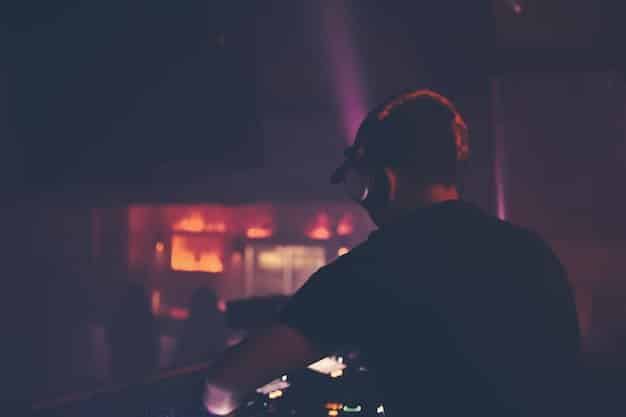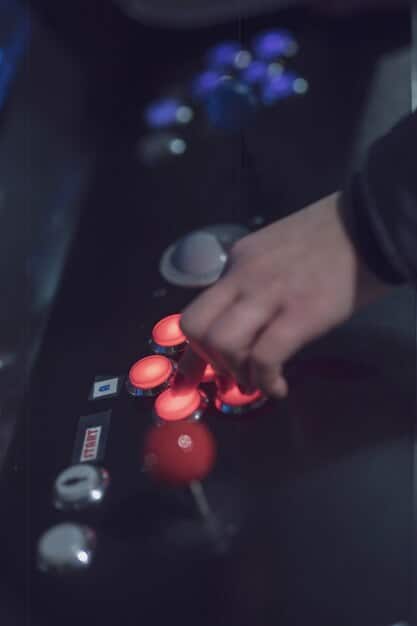Mastering DJing: Techniques & Tips for Underground Music Enthusiasts

For aspiring DJs in the underground music scene, mastering the art of DJing: techniques and tips for underground music enthusiasts involves cultivating a deep understanding of track selection, seamless mixing strategies, and innovative performance techniques to elevate sets from mere playback to unforgettable sonic journeys, blending technical skill with creative expression to captivate audiences.
Diving into the world of underground music means more than just appreciating the sounds; it’s about becoming a part of the movement. For those drawn to the decks, mastering the art of DJing: techniques and tips for underground music enthusiasts offers a gateway to transforming a passion for obscure beats into an electrifying performance. This guide aims to distill years of collective wisdom into actionable insights, helping you navigate the technical nuances and artistic expressions required to truly stand out.
The Foundation: Understanding Your Gear and Workspace
Before you can craft compelling narratives with sound, a fundamental understanding of your equipment is paramount. Knowing your tools intimately allows for seamless operation and creative manipulation, transforming potential technical hurdles into opportunities for expressive performance. This isn’t just about plugging things in; it’s about establishing a relationship with your instruments.
Deconstructing the Setup: Turntables, CDJs, and Controllers
The core of any DJ setup hinges on the playback devices. Each offers a unique tactile experience and sonic signature, influencing your mixing style and interaction with the music.
- Turntables: The classic choice for vinyl purists, offering unparalleled hands-on control and a distinct warm sound. They demand precision in beatmatching and a true understanding of pitch.
- CDJs/Media Players: Digital workhorses that bridge the gap between vinyl and pure digital. They offer advanced features like looping, hot cues, and waveform displays, making complex mixes more intuitive.
- DJ Controllers: All-in-one solutions that combine playback, mixer, and effects controls, typically integrated with DJ software. They are highly portable and often budget-friendly, ideal for beginners or those seeking maximum versatility.
Beyond the playback devices, the mixer serves as your command center, blending tracks, adjusting levels, and applying effects. Investing in a quality mixer with intuitive controls can significantly enhance your workflow and performance.
Essential Software and Digital Workflow
For digital DJs, the software is as crucial as the hardware. Programs like Serato DJ Pro, rekordbox, Traktor Pro, and Virtual DJ offer comprehensive features for track management, beatgrid analysis, and performance. Understanding how to efficiently organize your music library, analyze tracks for accurate BPM and key, and prepare cue points in advance can save precious time during a live set and prevent technical glitches.
A well-organized digital library is not merely about aesthetics; it’s a functional necessity. Categorizing tracks by genre, energy level, or even emotional resonance allows for rapid track selection, ensuring your flow remains unbroken. Utilize tagging features within your software to mark tracks for specific moments in a set, whether it’s an opener, a peak-time banger, or a late-night groove.
Moreover, keeping your software and firmware updated is crucial for performance and stability. Manufacturers frequently release updates that fix bugs, improve performance, and introduce new features. Ignoring these can lead to unexpected crashes or compatibility issues, which are unwelcome distractions during a performance.
Ultimately, a deep understanding of your gear and a meticulously organized digital workflow form the bedrock of successful DJing. This foundation allows you to transcend technical concerns and fully immerse yourself in the creative process, focusing your energy on the music and the audience.
Beatmatching and Blending: The Art of Seamless Transitions
The hallmark of a proficient DJ lies in their ability to transition smoothly between tracks, creating a seamless sonic journey rather than a series of abrupt changes. This fundamental skill, often referred to as beatmatching and blending, is where raw technical ability meets artistic finesse. It’s the magician’s sleight of hand, making two distinct pieces of music sound as if they were always meant to be together.
Mastering the Tempo: Manual Beatmatching
While modern DJ software and hardware feature sync buttons, understanding manual beatmatching remains a core skill. It trains your ear, improves your rhythmic timing, and provides a deeper connection to the music. Manual beatmatching involves adjusting the pitch of an incoming track to match the tempo of the playing track, aligning their beats to fall precisely together.
- Listen for the Kick Drum: The most prominent percussive element, the kick drum, is your primary guide for tempo. Listen intently to both tracks and adjust the pitch slider of the incoming track until their kicks align.
- Rhythmic Phrasing: Beyond simply matching the tempo, pay attention to the rhythmic phrasing of each track. Aligning musical phrases—introductions, breaks, and drops—creates a more organic and satisfying transition.
- Practice, Practice, Practice: Manual beatmatching takes time and dedication. Start with tracks with clear, prominent beats and gradually move to more complex arrangements. The goal is to achieve a consistent, imperceptible blend.
The beauty of manual beatmatching isn’t just in its technical execution, but in the heightened awareness it fosters. You become acutely attuned to the subtle shifts in rhythm and melody, allowing for more intuitive and creative blending decisions.
Techniques for Blending and Phrasing
Once beatmatched, the art of blending comes into play. This involves manipulating the EQ (equalization) and volume faders to seamlessly merge the sonic landscapes of two tracks. The goal is to introduce the new track gradually while gracefully fading out the old one, ensuring no harsh frequencies clash or dropouts occur.
A common technique involves using the bass frequency. As the new track is introduced, slowly bring up its bass while simultaneously cutting the bass of the outgoing track. This creates a smooth transfer of rhythmic energy without muddying the low end. Mid and high frequencies can then be blended in subtly, ensuring a balanced sound. Phrasing, on the other hand, is about understanding the musical structure of your tracks. Most electronic music is built on 8, 16, or 32-bar phrases. Initiating a blend at the beginning or end of a phrase ensures a naturally flowing transition, aligning with the musical intention of the tracks.
Beyond simple crossfading, explore different blending techniques. Try cutting the bass entirely on one track and letting the other’s bass carry the momentum, then slowly reintroducing the bass from the new track. Experiment with quick cuts for dramatic effect, or long, drawn-out blends for a more atmospheric transition. The key is to break free from formulaic approaches and develop a unique blending style that complements your musical selections.
Ultimately, mastering beatmatching and blending is an ongoing journey. It requires a keen ear, precise timing, and a willingness to experiment. The reward is the ability to weave together a cohesive auditory tapestry, captivating your audience with every smooth, intentional transition.
Expanding Your Sonic Palette: Effects and Creative Mixing
Once you’ve mastered the foundational elements of beatmatching and blending, the next step in your DJ journey is to elevate your sound through the intelligent use of effects and creative mixing techniques. Effects, when used judiciously, can add texture, depth, and excitement to your sets, transforming familiar tracks into fresh, dynamic experiences. The art lies not just in applying effects, but in understanding their purpose and timing to enhance, rather than detract from, the music.

Understanding Common DJ Effects
Modern mixers and DJ software come equipped with a myriad of effects, each offering unique sonic manipulation capabilities. Familiarizing yourself with the most common ones is crucial.
- Delay: Repeats a sound after a set period, creating echoes that can add atmospheric depth or rhythmic complexity. Useful for transitions, breakdowns, or adding a sense of space.
- Reverb: Simulates the natural ambiance of a space, making sounds appear as if they’re in a large room or hall. Excellent for creating dramatic buildups or enhancing emotional passages.
- Filter: Cuts or boosts specific frequency ranges, allowing you to sweep between muffled, bass-heavy sounds and bright, treble-rich tones. Perfect for creating tension, releasing energy, or teasing in new elements.
- Flanger/Phaser: Creates a swirling, jet-plane like effect by modulating the signal. Best used sparingly for a distinctive, otherworldly sound.
- Echo: A specific type of delay that creates distinct, repeating sounds, often used to create a sense of vastness or to highlight specific percussive elements.
Each effect has its sweet spot. Overuse can quickly lead to a cluttered or artificial sound. The key is to use them with intention, applying them subtly to highlight specific moments or to create seamless bridges between tracks.
Creative Mixing Beyond the Blend
Beyond traditional blending, creative mixing involves techniques that manipulate the structure and texture of the tracks themselves. This moves beyond simple transitions into performance art, allowing you to remix tracks live and infuse your unique personality into the set.
One powerful technique is looping. Select a small segment of a track—a powerful beat, a vocal snippet, or an intriguing synth riff—and loop it for varying durations. This can create tension, provide a foundation for a new track to come in, or extend a particularly captivating moment. Combine looping with filters to gradually build or strip away elements, adding dynamic interest.
Hot cues are another invaluable tool. These allow you to instantly jump to specific points within a track. Use them to skip dull intros, jump to iconic drops, or re-trigger samples. Combining hot cues with quick fader movements can create a rapid-fire, almost remix-like effect, adding an element of unpredictability to your performance.
Moreover, consider acapellas and instrumental overlays. By layering a vocal track over an instrumental, or vice versa, you can create entirely new compositions on the fly. This requires precise beatmatching and attentive EQing to ensure the elements blend harmoniously. Experiment with different combinations to discover unexpected synergies that ignite the dance floor.
Ultimately, the judicious application of effects and the exploration of creative mixing techniques transform your role from a mere track selector to a live sonic architect. It allows you to inject spontaneity and originality into your sets, delivering an experience that is uniquely yours and profoundly memorable.
Track Selection and Curation: Building a Cohesive Journey
The true artistry in DJing, especially within the nuanced world of underground music, extends far beyond technical proficiency; it resides in the meticulous craft of track selection and curation. A DJ is a storyteller, and their tracks are the words. Building a cohesive journey means understanding your audience, the venue, and the subtle energy shifts required to maintain engagement throughout a set. It’s about more than just playing “good” songs; it’s about playing the *right* songs at the *right* time, creating an immersive narrative that captivates and moves the crowd.
Understanding Your Audience and Venue
Before even considering what music to play, a discerning DJ assesses the environment. Who is the audience? Are they seasoned connoisseurs of obscure genres or a more mixed crowd willing to explore? What is the vibe of the venue—a dark, sweaty basement club, an open-air festival, or an intimate lounge?
The time of night also plays a crucial role. Early sets might call for warmer, more atmospheric tracks to build anticipation, while peak-time slots demand high-energy bangers. Late-night or after-hours sets often gravitate towards deeper, more introspective sounds. Tailoring your selection to these factors ensures your music resonates deeply with those present, fostering a genuine connection rather than a generic backdrop.
Curating Your Personal Sonic Signature
While adapting to the environment is key, a DJ must also cultivate their own unique sonic signature. This involves developing a keen understanding of various subgenres within underground music—from deep house to progressive techno, minimal, breakbeat, or electro—and recognizing how they can flow together. It’s about building a personal library that reflects your taste, while also containing enough versatility to cross boundaries and keep things fresh.
- Deep Dive into Discographies: Explore the entire catalogs of artists you admire. Often, their lesser-known tracks hold gems that can elevate your sets.
- Beyond the Top 10: While popular tracks have their place, dig deeper into independent labels, obscure releases, and even unreleased demos. This is where the truly unique sounds often lie.
- Genre Blending: Don’t be afraid to experiment with blending different subgenres. A well-executed transition from a hypnotic techno track into a soulful house groove can be incredibly effective and unexpected.
The process of curation is ongoing. Attend shows, listen to mixes from other DJs, and constantly seek out new music. Maintain a system for organizing your finds, whether it’s by mood, intensity, or potential transition points in a set. This meticulous preparation allows for spontaneous creativity during performance.
Structuring Your Set: The Narrative Arc
A truly memorable DJ set tells a story. It has an introduction, a rising action, a climax, and a natural winding down. This narrative arc is constructed through thoughtful track sequencing, managing energy levels, and incorporating moments of tension and release.
Start your set with tracks that ease the audience in, establishing a mood without overwhelming them. Gradually increase the energy and intensity, leading to peak-time tracks that ignite the dance floor. Introduce breakdowns and atmospheric moments to allow the crowd to breathe before building back up. Finally, bring the energy down gracefully, leaving the audience with a lasting impression rather than an abrupt ending.
This dynamic pacing ensures that your set feels like a journey, not just a random assortment of songs. It’s an intuitive dance between the DJ’s vision and the crowd’s response, constantly evolving in real-time. By mastering track selection and curation, you transcend mere technical skill, becoming a purveyor of atmosphere and an architect of unforgettable experiences.
Performance and Presence: Connecting with the Crowd
Beyond the technical mastery and meticulous track selection, a truly impactful DJ understands that performance is as much about presence and connection as it is about the music itself. In the underground scene, where authenticity reigns supreme, interacting with the crowd and projecting a genuine passion for the sound transforms a DJ set from a mere playback into a shared, visceral experience. It’s about becoming a conduit for the energy on the dancefloor, amplifying it and sending it back in waves of sound.
Reading the Room: The Art of Dynamic Flow
A fundamental aspect of performance is the ability to “read the room.” This involves an intuitive understanding of the crowd’s mood, energy levels, and desires. Are they ready for a deep, hypnotic groove, or do they crave an explosive peak-time banger? The best DJs are constantly in tune with the dancefloor, allowing the energy of the crowd to subtly influence their track selection and mixing decisions.
- Observe Body Language: Pay attention to how people are moving. Are they head-nodding, dancing freely, or just standing around? This provides immediate feedback.
- Listen to the Sounds: The collective roar or cheer of the crowd after a particularly effective drop or transition is a clear indicator of success.
- Feel the Atmosphere: Trust your gut. Sometimes, the energy in the room dictates a sudden shift or an extended groove, even if it deviates from your pre-planned sequence.
This dynamic responsiveness is what separates a good DJ from a truly great one. It’s the ability to adapt in real-time, pushing the boundaries when the crowd is receptive and pulling back when they need a moment to breathe.
Beyond the Booth: Engaging with Your Audience
While the focus is on the music, a DJ’s physical presence and non-verbal communication can significantly enhance the audience’s experience. This doesn’t mean becoming an overt entertainer, especially in the underground scene where the music often takes center stage. Instead, it’s about subtle cues that convey your passion and invite connection.
Maintain eye contact with individuals in the crowd. Smile, nod, or give a thumbs-up if someone is clearly enjoying a track. These small gestures create a sense of direct engagement, making the audience feel acknowledged and part of the performance. Allowing your body to move with the music, even subtly, demonstrates your immersion and infectious enthusiasm. This genuine enjoyment is often mirrored by the crowd.
However, avoid excessive showboating or constant self-promotion. In underground circuits, the music is usually the hero. Your role is to facilitate the experience, not overshadow it. A balanced approach means being present and engaged without becoming a distraction from the sonic journey you are crafting.
Ultimately, a compelling DJ performance merges technical skill with an acute awareness of the environment and a genuine connection with the audience. It’s about creating an atmosphere where music and people coalesce into a singular, unforgettable moment, driven by the DJ’s unwavering passion and responsive presence.
Building Your DJ Brand and Community
In the vibrant, interconnected world of underground music, mastering the art of DJing extends beyond simply playing great sets; it involves strategically building your personal brand and nurturing community connections. For the underground music enthusiast, this isn’t about traditional fame, but about establishing credibility, finding your niche, and contributing meaningfully to the scene. It’s about creating a reputation not just as a DJ, but as a tastemaker, a curator, and an integral part of the collective.
Crafting Your Online Presence
In the digital age, an online presence is non-negotiable for any aspiring DJ, even those focused on the underground. This doesn’t mean chasing viral trends, but rather creating a curated platform that showcases your unique sound and aesthetic. Think of it as your digital record bag, constantly updated and accessible.
- Mixcloud/SoundCloud: Essential platforms for sharing your mixes. High-quality recordings that accurately represent your live sound are crucial. Use compelling artwork and descriptive tracklists to attract listeners.
- Instagram/TikTok (Selective Use): Visual platforms can offer glimpses into your process, the venues you play, and the vibe of your sets. Focus on authentic content that resonates with the underground ethos, avoiding overly commercial or contrived posts.
- Personal Website/Link-in-Bio: A centralized hub for all your content—mixes, upcoming gigs, contact information, and even a brief artist statement or philosophy. This provides a professional touch and makes it easy for promoters and fans to find you.
Consistency is key. Regularly upload new mixes, share updates about your musical discoveries, and engage with comments. This demonstrates dedication and keeps your audience engaged, however small your initial following might be.
Networking and Community Engagement
The underground scene thrives on connection. Building genuine relationships within your local and global community is perhaps the most critical aspect of growing as a DJ. This is where opportunities arise, and where your unique sound can truly find its audience.
Attend other DJs’ sets, both established and emerging. Support local promoters and venues. Introduce yourself, express genuine appreciation for their work, and offer to help when possible. Being a supportive member of the scene often opens doors. Collaborate with other artists, whether it’s through back-to-back sets, joint live streams, or even sharing booth time at parties. Collaborative efforts expand your reach and expose you to new audiences. Organize or contribute to small, independent events, whether it’s a house party, an intimate gathering, or a pop-up. Creating your own opportunities demonstrates initiative and passion, drawing like-minded individuals to you.
Beyond formal networking, immerse yourself in the culture. Spend time in record stores, engage in online forums focused on specific genres, and participate in discussions about music. This deep immersion not only enriches your musical knowledge but also allows you to organically connect with peers and potential collaborators. Authenticity is paramount. In the underground, people quickly discern genuine passion from superficial self-promotion. Be generous with your knowledge, support others, and let your love for the music be your guiding principle. Building your brand and community is a slow burn, but it’s a rewarding journey that solidifies your place within the underground soundscape.
Ultimately, your brand isn’t just about how you play, but how you contribute to and uplift the culture around you. It’s about being an active, respected participant in the ever-evolving conversation of underground music.
Beyond the Decks: Lifelong Learning and Evolution
The journey of a DJ, especially within the dynamic realm of underground music, is never truly complete. It’s an ongoing process of discovery, refinement, and evolution. To remain relevant and inspired, a commitment to lifelong learning and a willingness to adapt are crucial. The musical landscape is constantly shifting, new technologies emerge, and personal tastes mature. Embracing this continuous evolution ensures that your passion for DJing remains vibrant and your sets continue to captivate.
Staying Relevant: Music Discovery and Trends
The underground scene is characterized by its constant innovation and the emergence of new sounds. To stay at the forefront, or even just abreast, of these developments requires diligent music discovery. This goes beyond passively listening to charts; it involves active exploration and a keen ear for emerging trends without sacrificing your unique sound.
- Dive into Record Pools and Blogs: Many digital record pools offer early access to unreleased tracks, while specialized blogs and online publications can highlight emerging artists and labels.
- Explore Bandcamp and Discogs: These platforms are treasure troves for independent artists and obscure releases, often revealing sounds that won’t be found on mainstream streaming services.
- Attend Local Gigs and Festivals: Experiencing music live from other DJs and producers provides invaluable inspiration and exposes you to tracks you might not discover otherwise.
While it’s important to be aware of trends, don’t blindly follow them. True creativity lies in integrating new sounds into your existing style, or even leading the charge in developing new subgenres. Your unique identity should remain paramount.
Expanding Your Skillset: Production and More
For many DJs, the natural progression is to venture into music production. Understanding how tracks are made can profoundly enhance your DJing, giving you a deeper appreciation for arrangement, sound design, and mixing. Even a basic understanding of production software (DAWs like Ableton Live, Logic Pro, or FL Studio) can open up new creative avenues, allowing you to create your own edits, remixes, or even original tracks to weave into your sets.
Beyond production, consider exploring other related skills:
- Visuals: Learning basic visual jockeying (VJing) or lighting control can enhance the overall experience of your sets, especially in intimate venues.
- Sound Engineering: A foundational understanding of sound engineering principles helps you optimize your sound in different acoustics and troubleshoot common audio issues.
- Music Theory: While not strictly necessary, a basic grasp of music theory can inform your key mixing decisions, allowing for more harmonious blends and creative track pairings.
These expanded skills not only make you a more versatile artist but also provide alternative avenues for creative expression within the broader music ecosystem.
Ultimately, the mark of a truly dedicated DJ is a relentless curiosity and a commitment to self-improvement. The underground thrives on innovation and authenticity. By continuously learning, exploring, and evolving your craft, you not only ensure your own longevity in the scene but also contribute to its vibrant and ever-changing landscape, leaving your indelible mark on the sonic tapestry of underground music.
| Key Aspect | Brief Description |
|---|---|
| 🎧 Gear Mastery | Understand your equipment (turntables, CDJs, controllers, software) for seamless, creative mixing. |
| 🎚️ Fluid Transitions | Master beatmatching, EQ manipulation, and phrasing to create cohesive sonic narratives. |
| ✨ Creative Expression | Utilize effects, looping, hot cues, and layering to add texture and personal flair to your sets. |
| 🤝 Community & Growth | Build your brand, connect with the scene, and commit to continuous learning and evolution. |
Frequently Asked Questions about DJing for Underground Music
▼
While technical skills like beatmatching are fundamental, the most crucial skill for an underground DJ often lies in track selection and curation. Understanding your audience, reading the room, and consistently delivering a unique, cohesive sonic journey that resonates with the specific vibe of the underground scene is paramount to a successful and respected DJ career.
▼
The best starting point depends on your personal preference, budget, and learning style. Vinyl offers a hands-on, authentic experience that builds strong foundational skills but can be costly. CDJs are industry standard and provide extensive features. Controllers offer a cost-effective, portable way to learn digital DJing. Many recommend starting with what feels most intuitive and accessible, then expanding later.
▼
Music theory is not strictly required to be a successful DJ, as many accomplished DJs primarily rely on their ear. However, a basic understanding of concepts like key, harmony, and song structure can significantly enhance your ability to create harmonious mixes, understand track progression, and make more informed decisions when blending different musical elements together.
▼
Active music discovery involves exploring independent labels on Bandcamp and Discogs, following specialized music blogs and podcasts, utilizing online record pools, and attending local underground parties. Network with other DJs and producers, share track IDs, and delve deep into artist discographies beyond their most popular releases. Consistency in exploration is key.
▼
Getting gigs in the underground scene often comes down to networking and proving your dedication. Start by attending local events, supporting other artists, and building genuine relationships with promoters and venue owners. Share high-quality mixes online, offer to open for established DJs, and consider organizing your own small events to showcase your talent and passion.
Conclusion
Embarking on the journey of mastering the art of DJing: techniques and tips for underground music enthusiasts is a deeply rewarding endeavor. It transcends mere button-pushing, evolving into a nuanced blend of technical skill, artistic expression, and meaningful community engagement. From understanding your foundational gear to crafting seamless transitions, exploring creative effects, and meticulously curating your sonic palette, each step builds upon the last, contributing to a truly impactful performance. Beyond the decks, nurturing your presence, connecting with the crowd, and fostering a genuine brand within the underground ecosystem are paramount. Ultimately, the most successful DJs are perpetual students, ever evolving, constantly discovering, and deeply committed to the raw, authentic spirit of underground music. This continuous pursuit of excellence not only elevates your craft but also enriches the vibrant tapestry of the global underground scene, ensuring its pulsating rhythm endures for generations to come.





